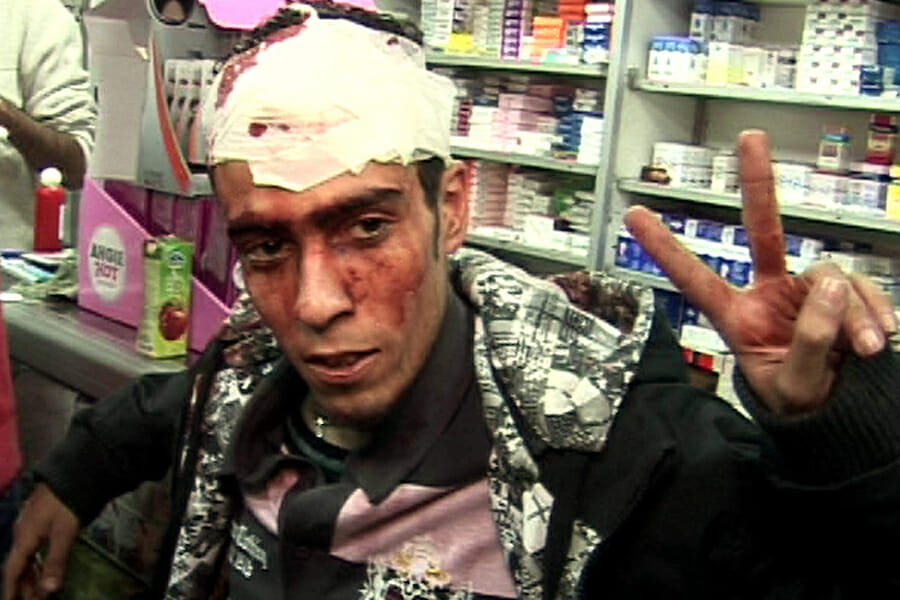
Interview with Fredrik Stanton, Director of ‘Uprising’
As with most historical events they are often best captured on film in a documentary format. Fredrik Stanton’s Uprising depicts the Egyptian people’s deposition of Egypt’s brutal dictator Hosni Mubarak, a quasi-military leader who for thirty years kept the country under emergency law and who was responsible for many deaths and disappearances. Egyptian citizens’ peaceful and effective protest against Mubarak’s injustice is a pure example of Gandhi’s concept of satyagraha. (In Egypt’s case – it was on a nearly unthinkable scale – 20 million people took to the streets in protest.) Gandhi described satyagraha in the following way:
There are two ways of countering injustice. One way is to smash the head of the man who perpetrates injustice and to get your own head smashed in the process…But through the other method of combating injustice, we alone suffer. This other method is satyagraha. One who resorts to it does not have to break another’s head; he may merely have his own head broken. He has to be prepared to die himself suffering all the pain.
The Egyptian uprising had all the hallmarks of being a protest movement with thousands marching in the streets and gatherings in Tahrir Square only to be put down by Egypt’s security and military. Conventional wisdom dictated, that as in past, the protest movement would be quickly put down by the Mubarak government and those responsible arrested.
However this did not happen and the movement grew finally including security forces who had once gathered to suppress the rebellion. Mubarak could no longer hold onto power once he lost the ability to control the narrative. He lost his legitimacy to stay in office.
Fredrik Stanton, director, writer, and producer of Uprising, is the author of Great Negotiations: Agreements that Changed the Modern World. He has appeared on C-Span’s “Washington Journal and Voice of America,” his writings have been published in the Washington Post, Forbes, Politico, the Boston Herald and the United Nations Association’s A Global Agenda. The former president and publisher of the Columbia Daily Spectator, he has served as an election monitor in Armenia, the Republic of Georgia, Bosnia, Kosovo and Azerbaijan.
We spoke to Fredrik Stanton on Friday the 18th of January 2013.
You’ve described the setting of the revolution in Egypt. The concept of peaceful non-violent protest juxtaposed with the emergence of social networking- near simultaneous communication by cell and Facebook – was the right mix for revolution.
This is a logical sequence to other 20th century wars or mass movements. The Vietnam War brought jungle warfare into the TVs of America’s living rooms. The Berlin Wall fell across the screens of thousands of cell phones. The revolution has already been televised. Fredrik, what was the spark that got this Egyptian revolution going? What made these people decide, “We’re having a revolution today – not a dialogue!”
Egypt’s uprising was originally a protest inspired by the killing of a young Egyptian man who could have been an Egyptian Everyman. A picture of his body was posted on Facebook. The page, “We are all Khaled Said” inspired rage and pity in all who saw it. It was a powerful motivator for protest.
Shortly after the posting of the Khaled Said pages the date of the January 25th Revolution was announced, on Facebook, eleven days before it was due to begin. It was unprecedented for a mass movement– a Facebook date, invitations, and people signaling whether or not they would be attending. (One of the spokespersons in the film, dubbed “Facebook Lady,” a Nobel Peace Prize nominee, describes this process.) The Facebook pages ignited the anger of thousands of Egyptians; brought them to the central Tahrir Square, and kept them informed moment by moment as to the whereabouts and activities of the protestors, the police, and the Army.
Social media like Facebook has dramatically changed the way we think and act and the way we organize. It has utterly changed geopolitics. A revolution that starts with a discussion between a few technologically sophisticated people (in Egypt relatively few people have laptops) spreads the word to the rest of the population; and they all spill out into to the streets, to take action. Events that might take days, weeks, take only minutes to transpire and to be broadcast and to inspire actions and reactions. Because of social media, there is nothing like the scale of the Egypt uprising in the history of popular movements.
Uprising (2013), a documentary written, edited, and produced by Fredrik Stanton, portrays the convergence of an uprising, a peaceful protest which transformed itself into a revolution. Spurred by rage at Mubarak’s 30 years of oppression, by the incendiary Khaled Said Facebook pages, and by Facebook and cell phone communications, the peaceful protestors turned themselves into true revolutionaries. They declared themselves willing and ready to face bullets and die at the hands of the army.
And the Egyptian army responded to them with violence, killing around 800 people and wounding over 6,000. But the Army and the police were vastly outnumbered. The Egyptian people, 20 million of them, massed all over the streets of Cairo, and two other cities around Egypt, were ranged against them. The Army had guns, bullets (rubber but still capable of inflicting significant damage), tear gas, batons and clubs. But its supplies and manpower were limited. As the Army ran out of men and bullets, opposition to the revolution finally collapsed.
The philosophy and tactics of Egypt’s uprising can be traced to an American named Gene Sharp, the world’s foremost expert on non-violent revolution, who trained Egyptians in organizing. The central message preached by Sharp is that “the power of dictatorships comes from the willing obedience of the people they govern – and that if the people can develop techniques of withholding their consent, a regime will crumble.” He has been proven correct in revolutions in the Arab World and in the former Soviet bloc, many times over.
Sharp ‘s philosophy was strongly influenced by Martin Luther King, who had in turn taken his inspiration from Gandhi’s concept of peaceful nonviolent protest – satyagraha – which at the heart contains a willingness to suffer and die for the cause.
Egyptians followed Gandhi’s (and Sharp’s) directions. They demonstrated that they were withholding their consent from the ruling regime.. And that they were willing to suffer and die for their cause. A phalanx of six men would link arms and march straight into the Army’s bullets. They would be shot, they would fall, and another phalanx would take their place. There were many more citizen phalanxes than there were Army responders—armed resistance faltered. And so the regime crumbled.
The documentary’s actors are a brilliant assemblage of people across class, gender, race, language, and professions. Actors, bloggers, politicians, academics. What they seem to have in common is a passion for telling their stories; a sense of solidarity; a sense of uplift, almost shock, and euphoria that they did it- they forced a seemingly untouchable dictator, Mubarak, to leave office. Their eloquence lends a touch of poetry to the scenes of guns and tear gas and blood.
They spoke very effectively about facing violence and being willing to die. “These were not just rubber bullets. His head just exploded in front of me. So much blood. I’ve never seen so much blood. There was a sense that freedom would not come cheap. Somewhere along the line I lost my fear of death. How do you die- with dignity or with cowardice?”
Their comments on the 30 years of the Mubarak regime were terse but effective. “The rule was oppression; there was a sense that ordinary people didn’t really matter.” People’s anger at Mubarak’s repression was so deep that it inspired them, as they said, “to take to the streets and get it [the revolution] done themselves.”
Fredrik, what inspired you to create a documentary about Uprising? You must have had extraordinary access. Can you tell us about this?
In fact, when I got started Egypt was not my usual field of operations, I couldn’t speak Arabic, and I didn’t know a soul. I started cold calling/emailing people (whose emails and cell numbers were often available on the web) who I knew would be key and who I guessed correctly would be proud of their role in the uprising and eager to talk about it. (There’s that sense of uplift you mentioned.) It was a small, tightly knit group. So that every person I spoke to in turn gave me references to other people, and it just snowballed. As a result, I did indeed have a cadre of powerful, cross class, cross-cultural people who had been activists in the uprising and were very eloquent in their descriptions.
We were able to get some wonderful stories. But there are thousands more powerful and moving stories out there.
But the story of the Egypt uprising, sadly, does not end here. Mubarak’s successor, President Mohammed Morsi, has assumed near absolute powers and begun to use them in a way, which recalls the worst excesses of the Mubarak regime. Mahmoud Fouly from CAIRO, Jan. 19 (for Xinhua) cited Mohamed ElBaradei, a leading opposition reform advocate, as saying that Morsi’s rule was “no different” than Mubarak’s.
“In fact, it is perhaps even worse,” the Nobel Peace Prize laureate told a news conference after he accused the president’s supporters of a “vicious and deliberate” attack on peaceful demonstrators outside the palace.
“Cancel the constitutional declarations, postpone the referendum, stop the bloodshed, and enter a direct dialogue with the national forces,” he wrote on his Twitter account, addressing Morsi.
The documentary’s description of the Mubarak and Morsi regimes, which feature attacks on peaceful protestors and the widespread detention and torture of citizens, reminded me very uncomfortably of the film Zero Dark Thirty about the hunt for Osama bin Laden.
The ethics of torture, specifically of waterboarding, and the persistence of torture as a Special Forces tactic despite its brutality and despite agents’ inability to prove its efficacy at extracting information– these are issues Americans too have been forced to face, in the viewing of the film. Our own government is not innocent. To encourage analysis and dialogue, it might be effective to see these films as a pair. Although the New York viewing is over, Uprising may still be seen in Pasadena.


